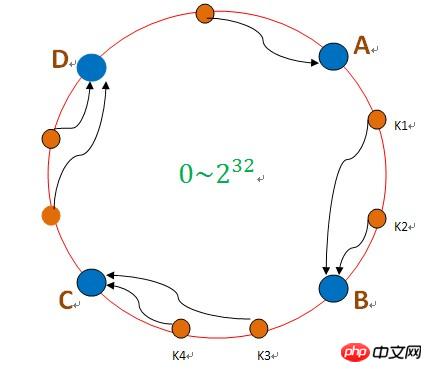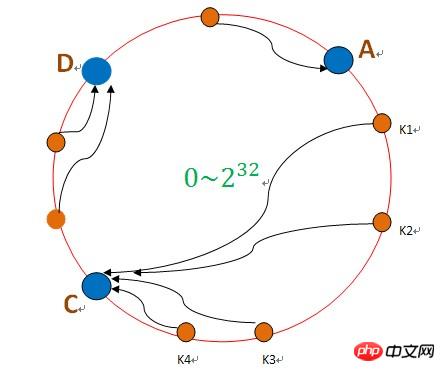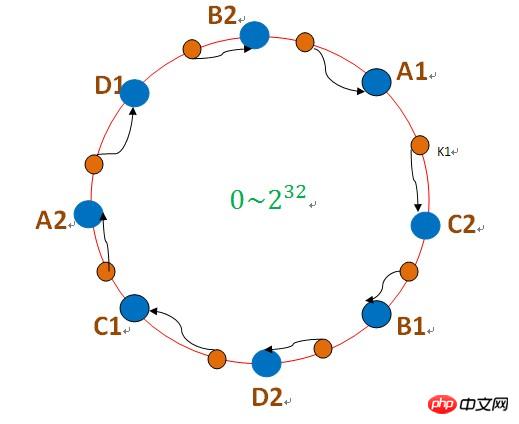 Backend Development
Backend Development
 PHP Tutorial
PHP Tutorial
 Detailed explanation of steps to implement consistent Hash algorithm in PHP
Detailed explanation of steps to implement consistent Hash algorithm in PHP
Detailed explanation of steps to implement consistent Hash algorithm in PHP
This time I will bring you a detailed explanation of the steps to implement the consistent Hash algorithm in PHP. What are the precautions for PHP to implement the consistent Hash algorithm? Here are practical cases, let’s take a look.
The consistent hash algorithm is a commonly used algorithm in distributed systems. Why should we use this algorithm? For example: a distributed storage system needs to store data on specific nodes (servers). If the number of servers does not change, if ordinary hash is used and then The method of taking the modulus of the total number of servers (such as key% the total number of servers), if a server goes down during the period or needs to add servers, problems will arise. After hashing the same key, the result modulo the total number of servers will be different from the previous result, which results in the loss of previously saved data. Therefore, the Consistent Hash (Consistent Hashing) distribution algorithm is introduced
Use the hash function (such as md5, sha1) to map the data to a ring, as shown in the figure above shows that when the data is stored, first calculate the hash value of the key according to the hash algorithm, which corresponds to the position in the ring. For example, k1 corresponds to the same position as shown in the figure. Then find the server node B in the clockwise direction, and then put k1 Save it to node B. If node B goes down, the data on B will fall to node C, as shown in the figure below
If node B goes down, the data on B will fall to node C, as shown in the figure below
 In order to solve this problem, the concept of "virtual node" is introduced: that is, imagine that there are many "virtual nodes" on the ring. A real server node corresponds to multiple virtual nodes. When storing data, If you find the virtual node in the clockwise direction of the ring, you will find the corresponding real server node. As shown in the figure below
In order to solve this problem, the concept of "virtual node" is introduced: that is, imagine that there are many "virtual nodes" on the ring. A real server node corresponds to multiple virtual nodes. When storing data, If you find the virtual node in the clockwise direction of the ring, you will find the corresponding real server node. As shown in the figure below

PHP implementation of consistent hash algorithm
An interface is given below/**
* 一致性哈希实现接口
* Interface ConsistentHash
*/
interface ConsistentHash
{
//将字符串转为hash值
public function cHash($str);
//添加一台服务器到服务器列表中
public function addServer($server);
//从服务器删除一台服务器
public function removeServer($server);
//在当前的服务器列表中找到合适的服务器存放数据
public function lookup($key);
}
are given below A specific implementation of this interface
/**
* 具体一致性哈希实现
* author chenqionghe
* Class MyConsistentHash
*/
class MyConsistentHash implements ConsistentHash
{
public $serverList = array(); //服务器列列表
public $virtualPos = array(); //虚拟节点的位置
public $virtualPosNum = 5; //每个节点对应5个虚节点
/**
* 将字符串转换成32位无符号整数hash值
* @param $str
* @return int
*/
public function cHash($str)
{
$str = md5($str);
return sprintf('%u', crc32($str));
}
/**
* 在当前的服务器列表中找到合适的服务器存放数据
* @param $key 键名
* @return mixed 返回服务器IP地址
*/
public function lookup($key)
{
$point = $this->cHash($key);//落点的hash值
$finalServer = current($this->virtualPos);//先取圆环上最小的一个节点当成结果
foreach($this->virtualPos as $pos=>$server)
{
if($point <= $pos)
{
$finalServer = $server;
break;
}
}
reset($this->virtualPos);//重置圆环的指针为第一个
return $finalServer;
}
/**
* 添加一台服务器到服务器列表中
* @param $server 服务器IP地址
* @return bool
*/
public function addServer($server)
{
if(!isset($this->serverList[$server]))
{
for($i=0; $i<$this->virtualPosNum; $i++)
{
$pos = $this->cHash($server . '-' . $i);
$this->virtualPos[$pos] = $server;
$this->serverList[$server][] = $pos;
}
ksort($this->virtualPos,SORT_NUMERIC);
}
return TRUE;
}
/**
* 移除一台服务器(循环所有的虚节点,删除值为该服务器地址的虚节点)
* @param $key
* @return bool
*/
public function removeServer($key)
{
if(isset($this->serverList[$key]))
{
//删除对应虚节点
foreach($this->serverList[$key] as $pos)
{
unset($this->virtualPos[$pos]);
}
//删除对应服务器
unset($this->serverList[$key]);
}
return TRUE;
}
}Then, let’s test the algorithm
$hashServer = new MyConsistentHash();
$hashServer->addServer('192.168.1.1');
$hashServer->addServer('192.168.1.2');
$hashServer->addServer('192.168.1.3');
$hashServer->addServer('192.168.1.4');
$hashServer->addServer('192.168.1.5');
$hashServer->addServer('192.168.1.6');
$hashServer->addServer('192.168.1.7');
$hashServer->addServer('192.168.1.8');
$hashServer->addServer('192.168.1.9');
$hashServer->addServer('192.168.1.10');
echo "增加十台服务器192.168.1.1~192.168.1.10<br />";
echo "保存 key1 到 server :".$hashServer->lookup('key1') . '<br />';
echo "保存 key2 到 server :".$hashServer->lookup('key2') . '<br />';
echo "保存 key3 到 server :".$hashServer->lookup('key3') . '<br />';
echo "保存 key4 到 server :".$hashServer->lookup('key4') . '<br />';
echo "保存 key5 到 server :".$hashServer->lookup('key5') . '<br />';
echo "保存 key6 到 server :".$hashServer->lookup('key6') . '<br />';
echo "保存 key7 到 server :".$hashServer->lookup('key7') . '<br />';
echo "保存 key8 到 server :".$hashServer->lookup('key8') . '<br />';
echo "保存 key9 到 server :".$hashServer->lookup('key9') . '<br />';
echo "保存 key10 到 server :".$hashServer->lookup('key10') . '<br />';
echo '<hr />';
echo "移除一台服务器192.168.1.2<br />";
$hashServer->removeServer('192.168.1.2');
echo "保存 key1 到 server :".$hashServer->lookup('key1') . '<br />';
echo "保存 key2 到 server :".$hashServer->lookup('key2') . '<br />';
echo "保存 key3 到 server :".$hashServer->lookup('key3') . '<br />';
echo "保存 key4 到 server :".$hashServer->lookup('key4') . '<br />';
echo "保存 key5 到 server :".$hashServer->lookup('key5') . '<br />';
echo "保存 key6 到 server :".$hashServer->lookup('key6') . '<br />';
echo "保存 key7 到 server :".$hashServer->lookup('key7') . '<br />';
echo "保存 key8 到 server :".$hashServer->lookup('key8') . '<br />';
echo "保存 key9 到 server :".$hashServer->lookup('key9') . '<br />';
echo "保存 key10 到 server :".$hashServer->lookup('key10') . '<br />';
echo '<hr />';
echo "移除一台服务器192.168.1.6<br />";
$hashServer->removeServer('192.168.1.6');
echo "保存 key1 到 server :".$hashServer->lookup('key1') . '<br />';
echo "保存 key2 到 server :".$hashServer->lookup('key2') . '<br />';
echo "保存 key3 到 server :".$hashServer->lookup('key3') . '<br />';
echo "保存 key4 到 server :".$hashServer->lookup('key4') . '<br />';
echo "保存 key5 到 server :".$hashServer->lookup('key5') . '<br />';
echo "保存 key6 到 server :".$hashServer->lookup('key6') . '<br />';
echo "保存 key7 到 server :".$hashServer->lookup('key7') . '<br />';
echo "保存 key8 到 server :".$hashServer->lookup('key8') . '<br />';
echo "保存 key9 到 server :".$hashServer->lookup('key9') . '<br />';
echo "保存 key10 到 server :".$hashServer->lookup('key10') . '<br />';
echo '<hr />';
echo "移除一台服务器192.168.1.8<br />";
$hashServer->removeServer('192.168.1.8');
echo "保存 key1 到 server :".$hashServer->lookup('key1') . '<br />';
echo "保存 key2 到 server :".$hashServer->lookup('key2') . '<br />';
echo "保存 key3 到 server :".$hashServer->lookup('key3') . '<br />';
echo "保存 key4 到 server :".$hashServer->lookup('key4') . '<br />';
echo "保存 key5 到 server :".$hashServer->lookup('key5') . '<br />';
echo "保存 key6 到 server :".$hashServer->lookup('key6') . '<br />';
echo "保存 key7 到 server :".$hashServer->lookup('key7') . '<br />';
echo "保存 key8 到 server :".$hashServer->lookup('key8') . '<br />';
echo "保存 key9 到 server :".$hashServer->lookup('key9') . '<br />';
echo "保存 key10 到 server :".$hashServer->lookup('key10') . '<br />';
echo '<hr />';
echo "移除一台服务器192.168.1.2<br />";
$hashServer->removeServer('192.168.1.2');
echo "保存 key1 到 server :".$hashServer->lookup('key1') . '<br />';
echo "保存 key2 到 server :".$hashServer->lookup('key2') . '<br />';
echo "保存 key3 到 server :".$hashServer->lookup('key3') . '<br />';
echo "保存 key4 到 server :".$hashServer->lookup('key4') . '<br />';
echo "保存 key5 到 server :".$hashServer->lookup('key5') . '<br />';
echo "保存 key6 到 server :".$hashServer->lookup('key6') . '<br />';
echo "保存 key7 到 server :".$hashServer->lookup('key7') . '<br />';
echo "保存 key8 到 server :".$hashServer->lookup('key8') . '<br />';
echo "保存 key9 到 server :".$hashServer->lookup('key9') . '<br />';
echo "保存 key10 到 server :".$hashServer->lookup('key10') . '<br />';
echo '<hr />';
echo "增加一台服务器192.168.1.11<br />";
$hashServer->addServer('192.168.1.11');
echo "保存 key1 到 server :".$hashServer->lookup('key1') . '<br />';
echo "保存 key2 到 server :".$hashServer->lookup('key2') . '<br />';
echo "保存 key3 到 server :".$hashServer->lookup('key3') . '<br />';
echo "保存 key4 到 server :".$hashServer->lookup('key4') . '<br />';
echo "保存 key5 到 server :".$hashServer->lookup('key5') . '<br />';
echo "保存 key6 到 server :".$hashServer->lookup('key6') . '<br />';
echo "保存 key7 到 server :".$hashServer->lookup('key7') . '<br />';
echo "保存 key8 到 server :".$hashServer->lookup('key8') . '<br />';
echo "保存 key9 到 server :".$hashServer->lookup('key9') . '<br />';
echo "保存 key10 到 server :".$hashServer->lookup('key10') . '<br />';
echo '<hr />';The running results are as follows
Add ten servers 192.168.1.1~192.168.1.10
Save key1 to server:192.168.1.2
Save key2 to server:192.168.1.1
Save key3 to server:192.168.1.6
Save key4 to server:192.168.1.8
Save key5 to server:192.168.1.9
Save key6 to server:192.168.1.10
Save key7 to server:192.168.1.7
Save key8 to server:192.168.1.4
Save key9 to server:192.168.1.7
Save key10 to server:192.168.1.4
Remove a server 192.168.1.2
Save key1 to server:192.168.1.7
Save key2 to server:192.168.1.1
Save key3 to server:192.168.1.6
Save key4 to server:192.168.1.8
Save key5 to server:192.168.1.9
Save key6 to server :192.168.1.10
Save key7 to server:192.168.1.7
Save key8 to server:192.168.1.4
Save key9 to server:192.168.1.7
Save key10 to server:192.168.1.4
Remove a server 192.168.1.6
Save key1 to server:192.168.1.7
Save key2 to server:192.168.1.1
Save key3 to server:192.168.1.3
Save key4 to server: 192.168.1.8
Save key5 to server:192.168.1.9
Save key6 to server:192.168.1.10
Save key7 to server:192.168.1.7
Save key8 to server:192.168.1.4
Save key9 to server:192.168.1.7
Save key10 to server:192.168.1.4
Remove a server 192.168.1.8
Save key1 to server:192.168.1.7
Save key2 to server:192.168 .1.1
Save key3 to server:192.168.1.3
Save key4 to server:192.168.1.10
Save key5 to server:192.168.1.9
Save key6 to server:192.168.1.10
Save key7 to server:192.168.1.7
Save key8 to server:192.168.1.4
Save key9 to server:192.168.1.7
Save key10 to server:192.168.1.4
Remove a server 192.168. 1.2
Save key1 to server:192.168.1.7
Save key2 to server:192.168.1.1
Save key3 to server:192.168.1.3
Save key4 to server:192.168.1.10
Save key5 To server:192.168.1.9
Save key6 to server:192.168.1.10
Save key7 to server:192.168.1.7
Save key8 to server:192.168.1.4
Save key9 to server:192.168.1.7
Save key10 to server:192.168.1.4
Add a server 192.168.1.11
Save key1 to server:192.168.1.7
Save key2 to server:192.168.1.1
Save key3 to server :192.168.1.11
Save key4 to server:192.168.1.10
Save key5 to server:192.168.1.9
Save key6 to server:192.168.1.10
Save key7 to server:192.168.1.7
Save key8 to server:192.168.1.4
Save key9 to server:192.168.1.7
Save key10 to server:192.168.1.4
Yes, you can see that consistent hashing is used Finally, regardless of whether to add servers or reduce servers, the integrity and uniformity of the data are guaranteed to the greatest extent.
I believe you have mastered the method after reading the case in this article. For more exciting information, please pay attention to other php Chinese websites. related articles!
Recommended reading:
thinkPHP framework automatic filling principle and usage detailed explanation
PHP decorator mode usage detailed explanation
The above is the detailed content of Detailed explanation of steps to implement consistent Hash algorithm in PHP. For more information, please follow other related articles on the PHP Chinese website!

Hot AI Tools

Undresser.AI Undress
AI-powered app for creating realistic nude photos

AI Clothes Remover
Online AI tool for removing clothes from photos.

Undress AI Tool
Undress images for free

Clothoff.io
AI clothes remover

Video Face Swap
Swap faces in any video effortlessly with our completely free AI face swap tool!

Hot Article

Hot Tools

Notepad++7.3.1
Easy-to-use and free code editor

SublimeText3 Chinese version
Chinese version, very easy to use

Zend Studio 13.0.1
Powerful PHP integrated development environment

Dreamweaver CS6
Visual web development tools

SublimeText3 Mac version
God-level code editing software (SublimeText3)

Hot Topics
 1386
1386
 52
52
 PHP 8.4 Installation and Upgrade guide for Ubuntu and Debian
Dec 24, 2024 pm 04:42 PM
PHP 8.4 Installation and Upgrade guide for Ubuntu and Debian
Dec 24, 2024 pm 04:42 PM
PHP 8.4 brings several new features, security improvements, and performance improvements with healthy amounts of feature deprecations and removals. This guide explains how to install PHP 8.4 or upgrade to PHP 8.4 on Ubuntu, Debian, or their derivati
 How To Set Up Visual Studio Code (VS Code) for PHP Development
Dec 20, 2024 am 11:31 AM
How To Set Up Visual Studio Code (VS Code) for PHP Development
Dec 20, 2024 am 11:31 AM
Visual Studio Code, also known as VS Code, is a free source code editor — or integrated development environment (IDE) — available for all major operating systems. With a large collection of extensions for many programming languages, VS Code can be c
 7 PHP Functions I Regret I Didn't Know Before
Nov 13, 2024 am 09:42 AM
7 PHP Functions I Regret I Didn't Know Before
Nov 13, 2024 am 09:42 AM
If you are an experienced PHP developer, you might have the feeling that you’ve been there and done that already.You have developed a significant number of applications, debugged millions of lines of code, and tweaked a bunch of scripts to achieve op
 How do you parse and process HTML/XML in PHP?
Feb 07, 2025 am 11:57 AM
How do you parse and process HTML/XML in PHP?
Feb 07, 2025 am 11:57 AM
This tutorial demonstrates how to efficiently process XML documents using PHP. XML (eXtensible Markup Language) is a versatile text-based markup language designed for both human readability and machine parsing. It's commonly used for data storage an
 Explain JSON Web Tokens (JWT) and their use case in PHP APIs.
Apr 05, 2025 am 12:04 AM
Explain JSON Web Tokens (JWT) and their use case in PHP APIs.
Apr 05, 2025 am 12:04 AM
JWT is an open standard based on JSON, used to securely transmit information between parties, mainly for identity authentication and information exchange. 1. JWT consists of three parts: Header, Payload and Signature. 2. The working principle of JWT includes three steps: generating JWT, verifying JWT and parsing Payload. 3. When using JWT for authentication in PHP, JWT can be generated and verified, and user role and permission information can be included in advanced usage. 4. Common errors include signature verification failure, token expiration, and payload oversized. Debugging skills include using debugging tools and logging. 5. Performance optimization and best practices include using appropriate signature algorithms, setting validity periods reasonably,
 PHP Program to Count Vowels in a String
Feb 07, 2025 pm 12:12 PM
PHP Program to Count Vowels in a String
Feb 07, 2025 pm 12:12 PM
A string is a sequence of characters, including letters, numbers, and symbols. This tutorial will learn how to calculate the number of vowels in a given string in PHP using different methods. The vowels in English are a, e, i, o, u, and they can be uppercase or lowercase. What is a vowel? Vowels are alphabetic characters that represent a specific pronunciation. There are five vowels in English, including uppercase and lowercase: a, e, i, o, u Example 1 Input: String = "Tutorialspoint" Output: 6 explain The vowels in the string "Tutorialspoint" are u, o, i, a, o, i. There are 6 yuan in total
 Explain late static binding in PHP (static::).
Apr 03, 2025 am 12:04 AM
Explain late static binding in PHP (static::).
Apr 03, 2025 am 12:04 AM
Static binding (static::) implements late static binding (LSB) in PHP, allowing calling classes to be referenced in static contexts rather than defining classes. 1) The parsing process is performed at runtime, 2) Look up the call class in the inheritance relationship, 3) It may bring performance overhead.
 What are PHP magic methods (__construct, __destruct, __call, __get, __set, etc.) and provide use cases?
Apr 03, 2025 am 12:03 AM
What are PHP magic methods (__construct, __destruct, __call, __get, __set, etc.) and provide use cases?
Apr 03, 2025 am 12:03 AM
What are the magic methods of PHP? PHP's magic methods include: 1.\_\_construct, used to initialize objects; 2.\_\_destruct, used to clean up resources; 3.\_\_call, handle non-existent method calls; 4.\_\_get, implement dynamic attribute access; 5.\_\_set, implement dynamic attribute settings. These methods are automatically called in certain situations, improving code flexibility and efficiency.



